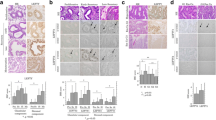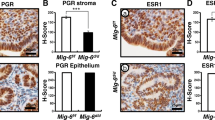Abstract
Metastin/kisspeptin is encoded by KISS1 and functions as an endogenous ligand of GPR54. Interaction of metastin with GPR54 suppresses metastasis and also regulates release of gonadotropin-releasing hormone, which promotes secretion of estradiol (E2) and progesterone (P4). We have previously demonstrated epigenetic regulation of GPR54 in endometrial cancer and the potent role of metastin peptides in inhibiting metastasis in endometrial cancer. However, little is known about how the metastin–GPR54 axis is regulated in the endometrium, the precursor tissue of endometrial cancer. Endometrial stromal cells (ESCs) and endometrial glandular cells (EGCs) within the endometrium show morphological changes when exposed to E2 and P4. In this study, we show that metastin expression is induced in ESCs through decidualization, but is repressed in glandular components of atypical endometrial hyperplasia (AEH) and endometrial cancer relative to EGCs. The promoter of GPR54 is unmethylated in normal endometrium and in AEH. These results indicate metastin may function in decidualized endometrium to prepare for adequate placentation but this autocrine secretion of metastin is deregulated during oncogenesis to enable tumor cells to spread.



Similar content being viewed by others
References
Kang HS, Baba T, Mandai M, Matsumura N, Hamanishi J, Kharma B et al (2011) GPR54 is a target for suppression of metastasis in endometrial cancer. Mol Cancer Ther 10:580–590
Ohtaki T, Shintani Y, Honda S, Matsumoto H, Hori A, Kanehashi K et al (2001) Metastasis suppressor gene KiSS-1 encodes peptide ligand of a G-protein-coupled receptor. Nature 411:613–617
Cejudo Roman A, Pinto FM, Dorta I, Almeida TA, Hernandez M, Illanes M et al (2012) Analysis of the expression of neurokinin B, kisspeptin, and their cognate receptors NK3R and KISS1R in the human female genital tract. Fertil Steril 97:1213–1219
Makri A, Msaouel P, Petraki C, Milingos D, Protopapas A, Liapi A et al (2012) KISS1/KISS1R expression in eutopic and ectopic endometrium of women suffering from endometriosis. In Vivo 26:119–127
Noyes RW, Hertig AT, Rock J (1975) Dating the endometrial biopsy. Am J Obstet Gynecol 122:262–263
Kosaka K, Fujiwara H, Tatsumi K, Yoshioka S, Higuchi T, Sato Y et al (2003) Human peripheral blood mononuclear cells enhance cell–cell interaction between human endometrial epithelial cells and BeWo-cell spheroids. Hum Reprod 18:19–25
Inoue T, Kanzaki H, Imai K, Narukawa S, Higuchi T, Katsuragawa H et al (1994) Bestatin, a potent aminopeptidase-N inhibitor, inhibits in vitro decidualization of human endometrial stromal cells. J Clin Endocrinol Metab 79:171–175
Marshburn PB, Head JR, MacDonald PC, Casey ML (1992) Culture characteristics of human endometrial glandular epithelium throughout the menstrual cycle: modulation of deoxyribonucleic acid synthesis by 17 beta-estradiol and medroxyprogesterone acetate. Am J Obstet Gynecol 167:1888–1898
Sugino N, Kashida S, Takiguchi S, Nakamura Y, Kato H (2000) Induction of superoxide dismutase by decidualization in human endometrial stromal cells. Mol Hum Reprod 6:178–184
Sugino N, Karube-Harada A, Sakata A, Takiguchi S, Kato H (2002) Different mechanisms for the induction of copper-zinc superoxide dismutase and manganese superoxide dismutase by progesterone in human endometrial stromal cells. Hum Reprod 17:1709–1714
Matsuoka A, Kizuka F, Lee L, Tamura I, Taniguchi K, Asada H et al (2010) Progesterone increases manganese superoxide dismutase expression via a cAMP-dependent signaling mediated by noncanonical Wnt5a pathway in human endometrial stromal cells. J Clin Endocrinol Metab 95:E291–E299
Liu M, Matsumura N, Mandai M, Li K, Yagi H, Baba T et al (2009) Classification using hierarchical clustering of tumor-infiltrating immune cells identifies poor prognostic ovarian cancers with high levels of COX expression. Mod Pathol 22:373–384
Estella C, Herrer I, Moreno-Moya JM, Quinonero A, Martinez S, Pellicer A et al (2012) miRNA signature and Dicer requirement during human endometrial stromal decidualization in vitro. PLoS One 7:e41080
Seminara SB, Messager S, Chatzidaki EE, Thresher RR, Acierno JS Jr, Shagoury JK et al (2003) The GPR54 gene as a regulator of puberty. N Engl J Med 349:1614–1627
de Roux N, Genin E, Carel JC, Matsuda F, Chaussain JL, Milgrom E (2003) Hypogonadotropic hypogonadism due to loss of function of the KiSS1-derived peptide receptor GPR54. Proc Natl Acad Sci USA 100:10972–10976
Messager S, Chatzidaki EE, Ma D, Hendrick AG, Zahn D, Dixon J et al (2005) Kisspeptin directly stimulates gonadotropin-releasing hormone release via G protein-coupled receptor 54. Proc Natl Acad Sci USA 102:1761–1766
Smith JT, Dungan HM, Stoll EA, Gottsch ML, Braun RE, Eacker SM et al (2005) Differential regulation of KiSS-1 mRNA expression by sex steroids in the brain of the male mouse. Endocrinology 146:2976–2984
Smith JT, Cunningham MJ, Rissman EF, Clifton DK, Steiner RA (2005) Regulation of Kiss1 gene expression in the brain of the female mouse. Endocrinology 146:3686–3692
Kinoshita M, Tsukamura H, Adachi S, Matsui H, Uenoyama Y, Iwata K et al (2005) Involvement of central metastin in the regulation of preovulatory luteinizing hormone surge and estrous cyclicity in female rats. Endocrinology 146:4431–4436
Lups S (1952) In memoriam Gerrit Van Veen. Ned Tijdschr Geneeskd 96:40
Adachi S, Yamada S, Takatsu Y, Matsui H, Kinoshita M, Takase K et al (2007) Involvement of anteroventral periventricular metastin/kisspeptin neurons in estrogen positive feedback action on luteinizing hormone release in female rats. J Reprod Dev 53:367–378
Horikoshi Y, Matsumoto H, Takatsu Y, Ohtaki T, Kitada C, Usuki S et al (2003) Dramatic elevation of plasma metastin concentrations in human pregnancy: metastin as a novel placenta-derived hormone in humans. J Clin Endocrinol Metab 88:914–919
Pita J, Barrios V, Gavela-Perez T, Martos-Moreno GA, Munoz-Calvo MT, Pozo J et al (2011) Circulating kisspeptin levels exhibit sexual dimorphism in adults, are increased in obese prepubertal girls and do not suffer modifications in girls with idiopathic central precocious puberty. Peptides 32:1781–1786
Jayasena CN, Nijher GM, Comninos AN, Abbara A, Januszewki A, Vaal ML et al (2011) The effects of kisspeptin-10 on reproductive hormone release show sexual dimorphism in humans. J Clin Endocrinol Metab 96:E1963–E1972
Sato Y, Fujiwara H, Konishi I (2010) Role of platelets in placentation. Med Mol Morphol 43:129–133
Park DW, Lee SK, Hong SR, Han AR, Kwak-Kim J, Yang KM (2012) Expression of Kisspeptin and its receptor GPR54 in the first trimester trophoblast of women with recurrent pregnancy loss. Am J Reprod Immunol 67:132–139
Logie JJ, Denison FC, Riley SC, Ramaesh T, Forbes S, Norman JE et al (2012) Evaluation of kisspeptin levels in obese pregnancy as a biomarker for pre-eclampsia. Clin Endocrinol (Oxf) 76:887–893
Bilban M, Ghaffari-Tabrizi N, Hintermann E, Bauer S, Molzer S, Zoratti C et al (2004) Kisspeptin-10, a KiSS-1/metastin-derived decapeptide, is a physiological invasion inhibitor of primary human trophoblasts. J Cell Sci 117:1319–1328
Gunderson CC, Fader AN, Carson KA, Bristow RE (2012) Oncologic and reproductive outcomes with progestin therapy in women with endometrial hyperplasia and grade 1 adenocarcinoma: a systematic review. Gynecol Oncol 125:477–482
Ushijima K, Yahata H, Yoshikawa H, Konishi I, Yasugi T, Saito T et al (2007) Multicenter phase II study of fertility-sparing treatment with medroxyprogesterone acetate for endometrial carcinoma and atypical hyperplasia in young women. J Clin Oncol 25:2798–2803
Scott G, Ahmad I, Howard K, MacLean D, Oliva C, Warrington S et al (2013) Double-blind, randomized, placebo-controlled study of safety, tolerability, pharmacokinetics and pharmacodynamics of TAK-683, an investigational metastin analogue in healthy men. Br J Clin Pharmacol 75:381–391
Jayasena CN, Nijher GM, Abbara A, Murphy KG, Lim A, Patel D et al (2010) Twice-weekly administration of kisspeptin-54 for 8 weeks stimulates release of reproductive hormones in women with hypothalamic amenorrhea. Clin Pharmacol Ther 88:840–847
Jayasena CN, Nijher GM, Chaudhri OB, Murphy KG, Ranger A, Lim A et al (2009) Subcutaneous injection of kisspeptin-54 acutely stimulates gonadotropin secretion in women with hypothalamic amenorrhea, but chronic administration causes tachyphylaxis. J Clin Endocrinol Metab 94:4315–4323
Fujiwara H, Jobo T, Takei Y, Saga Y, Imai M, Arai T et al (2012) Fertility-sparing treatment using medroxyprogesterone acetate for endometrial carcinoma. Oncol Lett 3:1002–1006
Conflict of interest
The authors declare no conflict of interest.
Author information
Authors and Affiliations
Corresponding author
Electronic supplementary material
Below is the link to the electronic supplementary material.
Rights and permissions
About this article
Cite this article
Baba, T., Kang, H.S., Hosoe, Y. et al. Menstrual cyclic change of metastin/GPR54 in endometrium. Med Mol Morphol 48, 76–84 (2015). https://doi.org/10.1007/s00795-014-0081-0
Received:
Accepted:
Published:
Issue Date:
DOI: https://doi.org/10.1007/s00795-014-0081-0




